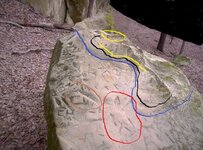dsty
Bronze Member
dsty & tinman, would like to know if there's any interest in knowing where / how / Churches are layed out and found
Last edited:
 They're from the early half of the 1700s....maybe earlier.
They're from the early half of the 1700s....maybe earlier.
Hello mdog and SS, thanks for the maps They seem to have 5 squares between compass points which fits wonderful with what I think is going on, Bill the copper mind on Red R. that we talked about in the past turned out to be a vault 6 ft high, in a circular room about 10 feet across, we determined that was where monies was stored for the settlers from new spain, the trail went from the vault to a point 12.5 miles west, then turned south for another 12.5 miles to what the local folks call the Viking baths that been posted in old hand dug holes, seems what we call sections = 1 mile square, their sections were 2.5 miles square, our townships are 36 sections, theirs were 25 leagues square, they had a Place of Worship in the Center with something of value also as did the settlers, information that I believe is correct was 112---- 1 pound bars of oro. The Viking Baths support the information with the Vault and all the other information that's carved at the location. Anyway its really been fun. That's why I feel that its important to find the Old Churches, Easy to locate
Would folks that posted egg's would you post them here and we can talk about them Thanks, size H-- W--- L
